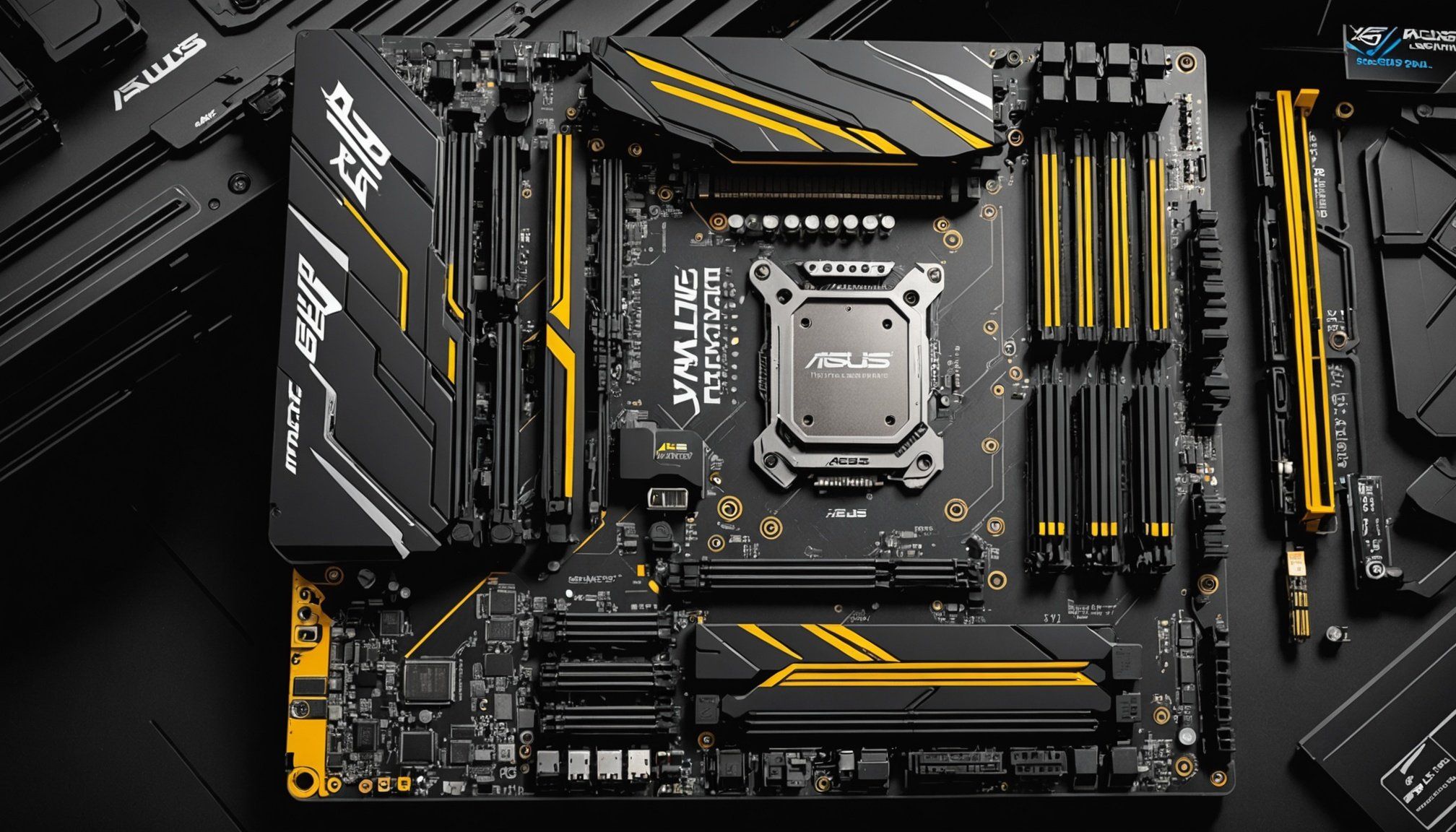Unlocking Peak Performance: Key NVMe SSD Configuration Strategies for Your ASUS TUF Gaming X570-Plus
When it comes to building a high-performance gaming PC, the ASUS TUF Gaming X570-Plus motherboard is an excellent choice, especially when paired with NVMe SSDs. Here’s a comprehensive guide to help you unlock the full potential of your setup.
Understanding NVMe SSDs and the ASUS TUF Gaming X570-Plus
To start, let’s delve into the world of NVMe SSDs and the ASUS TUF Gaming X570-Plus motherboard.
Also to see : Ultimate guide to strengthening small business security: how to install and configure a firewall on your pfsense system
What are NVMe SSDs?
NVMe SSDs, or Non-Volatile Memory Express Solid State Drives, are designed to leverage the speed of flash storage. They offer significantly higher read and write speeds compared to traditional SSDs, resulting in faster loading times and enhanced system responsiveness. For gaming enthusiasts and productivity-oriented users, these speeds can be a game-changer, providing competitive advantages in games and efficient workflow management[1].
The ASUS TUF Gaming X570-Plus Motherboard
The ASUS TUF Gaming X570-Plus motherboard is engineered to support the latest AMD Ryzen processors and features dual PCIe 4.0 M.2 slots, which are perfect for NVMe SSDs. This motherboard boasts military-grade components, upgraded power solutions, and comprehensive cooling options, ensuring rock-solid performance and stability. The support for PCIe 4.0 allows for faster data transfers, maximizing the capabilities of high-performance NVMe storage solutions[3].
Also read : Unleash gaming performance: optimizing your ryzen 9 5900x and rtx 3090 in a corsair 5000d airflow case
BIOS Configuration for Optimal SSD Performance
Configuring the BIOS correctly is crucial for unlocking the full potential of your NVMe SSDs.
Accessing the BIOS
To access the BIOS on your ASUS TUF Gaming X570-Plus, press the “Del” key immediately when the system starts. If this doesn’t work, try the “F2” key as an alternative entry command[1].
Key Configuration Options
Once in the BIOS, you need to ensure the following settings are configured correctly:
- M.2 Configuration: Activate the M.2 slots to ensure your NVMe SSDs are recognized and functioning at their best.
- SATA Mode: Switch the SATA mode to AHCI (Advanced Host Controller Interface) for better compatibility and performance. This setting is critical for avoiding potential bottlenecks and enabling faster boot and application loading times[1].
Recommended NVMe SSD Models for the ASUS TUF Gaming X570-Plus
Choosing the right NVMe SSD is essential for optimal performance.
Top Recommendations
Here are some of the best NVMe SSDs compatible with the ASUS TUF Gaming X570-Plus:
-
Samsung 970 EVO Plus:
-
Read speeds up to 3,500 MB/s and write speeds of 3,300 MB/s.
-
Known for its superior speed and reliability, making it a reliable choice for gaming and intensive tasks[1].
-
WD Black SN750:
-
Impressive read and write speeds surpassing 3,000 MB/s.
-
Offers a competitive price-to-performance ratio, designed specifically for gamers and creatives[1].
-
Crucial P5 Plus:
-
Read speeds up to 6,600 MB/s.
-
An attractive budget option without sacrificing much on performance, ensuring compatibility with the ASUS TUF Gaming X570-Plus[1].
Utilizing RAID Setups for Enhanced Performance
For those seeking even higher performance, configuring SSDs in a RAID setup can be highly beneficial.
RAID Configurations
- RAID 0: This setup splits data into writing pieces across multiple SSDs, providing a maximum speed boost. However, it does not offer redundancy, so data safety is compromised.
- RAID 1: This setup mirrors data across drives, providing redundancy but at the cost of some performance. It’s ideal if data safety is a priority[1].
Heat Management Strategies
Efficient heat management is crucial for sustaining SSD performance.
Cooling Solutions
- Heatsinks and Fans: Implement cooling solutions such as heatsinks or fans, especially if your setup supports it. The ASUS TUF Gaming X570-Plus features an actively cooled heatsink to prevent throttling during sustained transfers.
- Air Duct and Fan Design: The custom low-noise fan with a high-durability bearing and a specially-designed air duct helps generate static pressure and concentrates airflow over the fins, optimizing heat dissipation[3].
Additional Features and Considerations
The ASUS TUF Gaming X570-Plus offers several other features that enhance performance and user experience.
Power Design and Cooling
- CPU VRM: The motherboard utilizes 12+2 Dr. MOS power stages, combining high-side and low-side MOSFETs and drivers into a single package, delivering the power and efficiency demanded by AMD’s latest processors.
- 6-Layer PCB Design: Multiple PCB layers shift heat away from critical components, providing more headroom to push CPUs beyond stock speeds[3].
Memory and Storage Support
- ASUS OptiMem: This proprietary memory design unleashes the full performance potential of AMD’s Infinity Fabric architecture by enabling higher memory frequencies and lower latencies.
- Dual PCIe 4.0 M.2 Slots: Support up to type 22110 and provide NVMe SSD RAID support for an incredible performance boost[3].
Connectivity and Audio Features
- USB 3.2 Gen 2 Type-C: Offers ultrafast transfer speeds.
- Intel Wi-Fi & BT 5.0: Provides robust wireless connectivity.
- Realtek S1200A Audio Codec: Features an unprecedented 108dB signal-to-noise ratio for pristine audio quality[3].
Practical Insights and Actionable Advice
Here are some practical tips to help you get the most out of your setup:
Move Your Operating System to an SSD
Moving your operating system to an NVMe SSD can significantly improve boot times and overall system responsiveness. This is because NVMe SSDs handle read and write operations much faster than traditional hard drives or even SATA SSDs[4].
Regularly Update Your BIOS
Keeping your BIOS updated is crucial for ensuring compatibility with the latest hardware and optimizing performance. Regular updates often include bug fixes and performance enhancements.
Monitor and Manage Heat
Regularly check the temperatures of your components, especially during intense gaming or productivity sessions. Ensure that your cooling solutions are functioning correctly to prevent thermal throttling.
Detailed Comparison of Recommended NVMe SSDs
Here is a detailed comparison of the recommended NVMe SSDs:
| Model | Read Speed | Write Speed | Durability | Price Range |
|---|---|---|---|---|
| Samsung 970 EVO Plus | Up to 3,500 MB/s | Up to 3,300 MB/s | High | Premium |
| WD Black SN750 | Up to 3,500 MB/s | Up to 3,000 MB/s | High | Mid-Range |
| Crucial P5 Plus | Up to 6,600 MB/s | Up to 5,000 MB/s | High | Budget-Friendly |
Unlocking the peak performance of your ASUS TUF Gaming X570-Plus motherboard with NVMe SSDs involves several key strategies. From configuring the BIOS correctly to utilizing RAID setups and efficient heat management, each step is crucial for maximizing your system’s potential.
As ASUS notes, “The TUF Gaming X570-Plus (Wi-Fi) distills the essential elements of the latest AMD platform and combines them with game-ready features and proven durability,” making it an ideal choice for those seeking high-performance gaming and productivity[3].
By following these guidelines and choosing the right NVMe SSDs, you can ensure your system operates at its best, providing you with the fastest loading times, enhanced system responsiveness, and a superior gaming experience. Remember, the synergy between the ASUS TUF Gaming X570-Plus and high-performance NVMe SSDs is what sets your PC apart from the rest.











